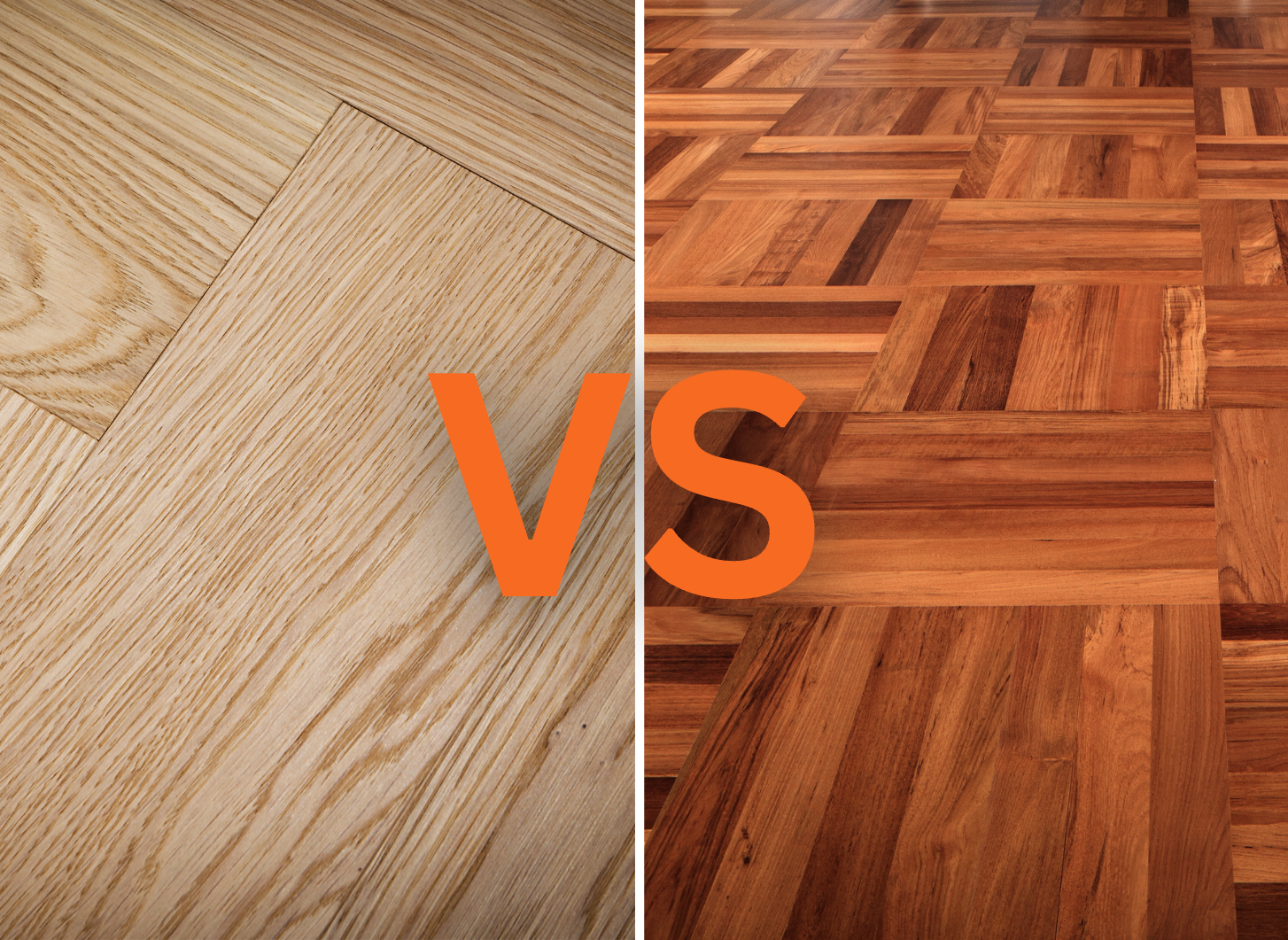

26 Jan Hardwood Flooring vs Oak Timber Flooring
Real timber flooring is sought after for its irreplaceable natural beauty. Akin to snowflakes, every plank of wood flooring is unique. There are many different species of real timber floors and categories, including innovative waterproof real wood flooring!
Today we’re going to look at the ins and outs of local Australian timber versus European oak timber. Furthermore, this article will explain the difference between solid timber flooring and engineered timber flooring.
What is the difference between Australian Hardwood & European Oak?
While Australian hardwood flooring is typically made from Australian eucalyptus, Oak timber flooring comes from the United States and Russia, Germany, France and other parts of Europe. There are key differences between the two major categories of wood flooring.
Surface Durability & Janka Rating
While both Australian hardwood and European Oak flooring are known for their hardness and durability, Australian timbers tend to be more durable against scratches and dents.
The durability of timber is measured through a “Janka Test” where steel balls are dropped onto a plank from different heights before the dent size is recorded. Tougher and denser woods will have a higher Janka Rating. Most Australian timbers have a Janka Rating from 9.0 – 12.0kN whereas oak woods range from 6.0 – 9.0kN
It is important to understand that just because a timber species is grown in Australia doesn’t always mean it is stronger and harder wearing than an oak wood. Every species has it’s own Janka Rating, for example some Australian softwoods like Cypress Pine are weaker than American Hickory.
Winner: Aussie timber flooring tends to be slightly stronger than European oak flooring.
Moisture Resistance
European oak tends to have greater moisture resistance than Australian timbers, although they are very similar. Natural wood will always warp and swell when exposed to excessive moisture. Higher-density timbers tend to be more susceptible to water damage. Because Australian hardwoods tend to more dense, the drawback is that they are slightly less moisture resistant.
While Australian hardwood isn’t as naturally water resistant, a variant called HydroPro Australian Engineered timber flooring is the most cutting-edge 99% waterproof hardwood on the market today. We will explore this option more later in the article.
Winner: European & American oak tends to be slightly more water resistant.
Design & Aesthetics
While this is a more subjective aspect, European Oak is generally considered more desirable for its unique looks and texture profile. Oakwoods exude beauty through their natural grain patterns that you can both see and touch… which Australian timber floors generally cannot replicate. This is because our local hardwood floors tend to be glossy and flat instead. Aussie timber floors also come in a more limited range of colours as they are harder to stain into different colours. Oak wood is lighter than our hardwoods, which mean it is very easy to stain the surface of oak.
Oak timbers are better when trying to achieve a Modern, Hampton or Scandinavian interior design. This is because they offer lighter colour palettes that our hardwoods do not have. Australian timbers on the other hand are great for rustic or warm interiors as they colours are a lot stronger and darker than most oak wood floors.
While nothing is stopping you from using Australian hardwood to design a truly classy room, European Oak timber simply has more versatility to it. Odds are it will be the better choice for your home.
Winner: Subjective, but usually oak timber flooring is more desirable aesthetically.
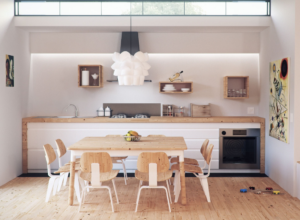

Sustainability
If sustainability is an important factor for you, you’re in luck. European oak and many Australian hardwoods are ethically and sustainably sourced. Many of the lumber companies involved in the harvesting of these woods are engaged in modern ethical practices to acquire them in a reasonable manner.
The key to sustainable timber shopping is to only purchase wood that is PEFC Certified and FSC Certified. This means the wood is sourced from regulated plantation timber rather than from unregulated logging in nature. We can all help the planet by supporting sustainable companies.
Another factor to consider is that engineered timber flooring options require less real timber to manufacture compared to solid timber floors. This means engineered floors are less demanding on timber plantations.
Winner: Tie – Look for PEFC and FSC certified wood flooring options.
Pricing of Different Timber Flooring Types
The price of timber flooring depends less on whether they are locally sourced or from overseas, but instead on how much real wood they contain. Timber is becoming more of a commodity because they are less readily available, with most hardwoods and oaks taking upwards of 40 years to reach maturity.
Cost of Australian Solid Timber Flooring
The cost of Australian solid timber flooring ranges from $80 – $150 per square metre for supply only. Factors influencing the cost include the grade of timber and the width of each plank. Select grade solid timber flooring is more popular as they have less dark knots and variations, however, are more expensive. Wider planks are harder to source, and hence also increase the price per square metre.
Cost of Oak Solid Timber Flooring
Solid oak wood is much harder to source in Sydney and hence commands an even higher price, typically $120 – $250 per square metre for supply only. Most oak timber is only available in engineered flooring.
Cost of Engineered Timber Flooring
Aussie engineered timber floors ranges from $85 – $130 per square metre depending largely on the thickness of the real timber veneer on the surface. Thicker wood veneers require more natural wood to make, and hence increase the price per square metre.
Engineered oak flooring is similarly priced, however slightly more affordable at $70 – $130 per square metre. Once again, thicker natural timbers on the surface means it will be more expensive.
Winner: Depends on whether you want solid or engineered timber flooring.
You can learn more about the cost of installing new timber flooring, whether engineered or solid through our complete flooring cost guide!
Types of Hardwood flooring
Australian Solid Timber Flooring
As the name suggests, solid timber flooring consists of wood all the way through the plank. In other words, solid hardwood isn’t a mixture of smaller layers stuck or glued together, and is entirely the same timber species from top to bottom.
With proper installation and maintenance, solid hardwood flooring can last 50 years or sometimes even more. This is because solid timber flooring can be sanded and polished multiple times over its lifespan. This process is done every decade or two when wear and tear catch up, ultimately making your solid hardwood floors look brand new.
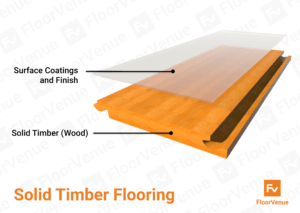

Engineered Timber Flooring
Engineered hardwood is characterized by its multi-layer construction style. While solid timber flooring consists of a full plank of wood, engineered hardwood flooring has surface of real timber bonded onto a plywood or composite core for increased stability and reduced cost.
Many people opt for engineered hardwood over solid hardwood flooring because not only is it cheaper, but has greater stability, better resistance to temperature fluctuations. Engineered hardwood flooring is generally much faster to install is because they don’t have to be glued and nailed like solid timber flooring. It’s also more water resistant with some options even boasting a 100% waterproof core. This makes some engineered timber floors more suitable for splash areas like the kitchen or laundry.
The drawback is that not all engineered timber flooring can be sanded and polished. The thicker the hardwood veneer, the more times you can sand and refinish the floor, and the longer it will last. Any timber with 3mm of real wood or upwards can be sanded and polished at least once.
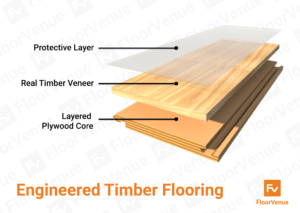

HydroPro Aussie Timber Flooring
A more unique type of timber flooring, HydroPro Aussie flooring has superior water resistance that protects your floor from warping and excessive moisture. It can be considered a counterpart to engineered hardwood flooring as it uses a composite limestone core instead of a plywood one.
The innovative limestone core is 100% waterproof and much denser, adding many extra years to the lifespan of the flooring material. Furthermore, the core contains sound-absorbing channels that reduce the amount of noise absorption. In fact, HydroPro timber has superior acoustic performance compared to traditional plywood-based engineered flooring.
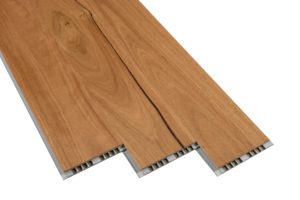

Types of Oak Timber Flooring
Solid European Oak Flooring
Unlike its Australian counterpart, solid European Oak has a stark difference in appearance. Despite the fact that it sometimes goes by the name of White Oak, it has a darker shade compared to Australian hardwood. The color is typically a combination of yellow and light brown.
European Oak is also known for its luxurious, high-profile look. The color and the grain have a very unique yet classy look to them that makes European Oak a popular choice for high-end projects.
Engineered European Oak Flooring
While eucalyptus is a common component of Australian engineered hardwood, European oak flooring that’s engineered tends to use Birch instead.
It also tends to be a thicker engineered hardwood flooring type overall. It usually measured around 2 – 6mm whereas the Australian variant is around 0.6 – 3mm. This allows for more resanding of European oak over the lifespan of the floor which is great. However, most oak woods are surface stained only which means the colour will revert to natural oak when sanded down.
HydroPro Oak Timber Flooring
One of the most durable and water-resistant oak flooring types out there, this special HydroPro flooring is highly dense and is capable of being re-polished and re-sanded. HydroPro Oak uses the same 100% waterproof core as HydroPro Australian timber. It also offers several layers of UV protection on the wear surface, giving it fantastic resistance to sunlight and heat as well.
Conclusion – Is Australian Hardwood or European Oak Flooring Better?
Whilst there are pros and cons of both, they are both natural timbers from two hemispheres of the world. The “better” wood floor really depends on your individual taste and the interior design you are trying to achieve.
Are you looking to learn more? We have a complete guide on solid wood flooring and a separate complete guide on the pros and cons of engineered flooring.
If you still have any remaining concerns about the benefits, uses or differences of Australian hardwood vs Oak Timber flooring, contact Floor Venue at any time and we’ll consult with you and answer any question you have.




























